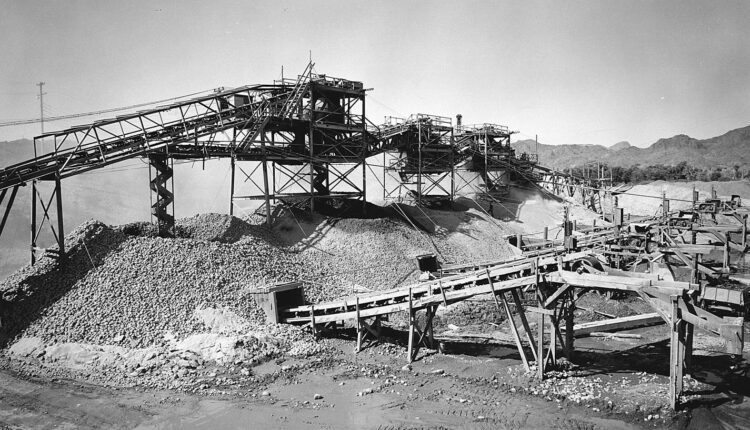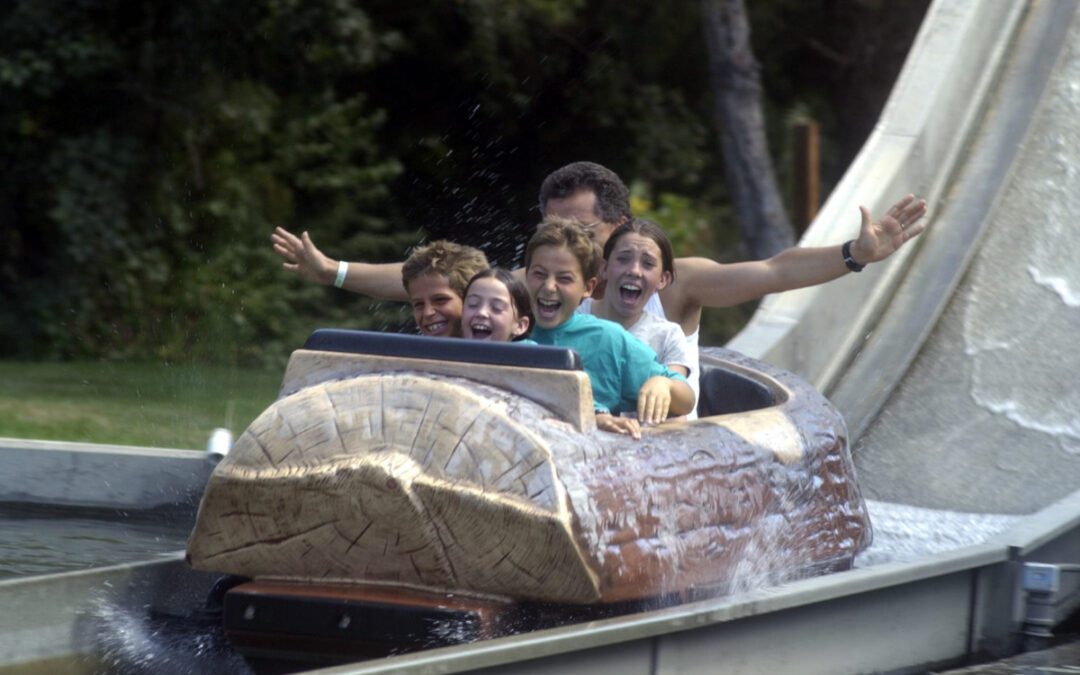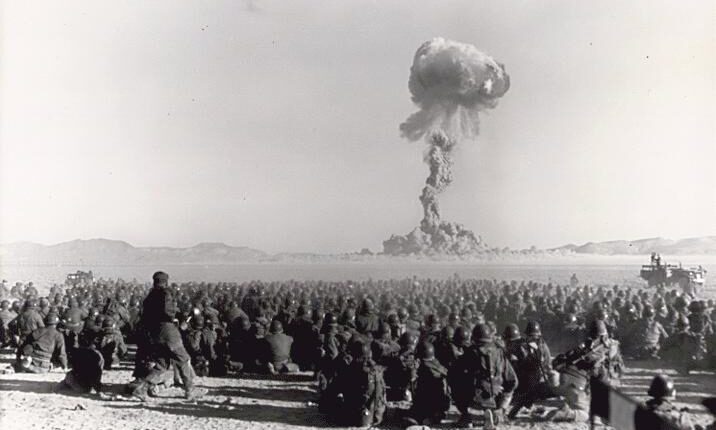
Now a boat-friendly freshwater dive site at Boulder Basin, the Hoover Dam’s aggregate classification plant produced more than nine million tons of aggregate during dam construction. (National Park Service)
From fighter jets to ghost towns, here are 7 sunken treasures hiding in the waters of Lake Mead and Hoover Dam.
There aren’t any mystical mermaids or scaley sea serpents living under Hoover Dam or Lake Mead, but the dam’s impounded reservoir on the Colorado River is home to a secret underwater world.
The largest manmade reservoir in the United States, Lake Mead is hiding everything from fighter jets to entire towns. Since the lake’s water level has dropped dramatically over the years due to drought and water usage, some hidden treasures have reemerged. Some are explorable via underwater expeditions while others can be visited by foot. For more information, you can visit the Lake Mead National Recreation Area Scuba Diving website.
In the meantime, here are seven sunken treasures hiding in the waters of Lake Mead and Hoover Dam.
1. St. Thomas
Not everything that happens under Lake Mead, stays under Lake Mead. Such is the case with St. Thomas, a former frontier town turned underwater ghost town turned historical site. Flooded to the point of complete submersion during the formation of Hoover Dam and Lake Mead in the 19th century, St. Thomas is making a comeback in the 21st century.
St. Thomas was founded in 1865 as a Mormon settlement with about 500 residents at its peak. However, the town’s final resident left via rowboat in 1938. The town sat under more than 60 feet of water at its tallest structural point, until its ruins began to reemerge in the early 2000s due to the lake’s receding waters.
Located in the northern part of the Lake Mead National Recreation Area, along the Muddy River near Overton, you can visit St. Thomas in person. It is accessible via a three-mile dirt trail with a trailhead and parking area. The drive to the trailhead is bumpy, but once you’re there, you can view the site from higher ground or head down the trail to walk around the streets and see the remains up close. You can also check out the Lost City Museum in Overton to see artifacts recovered from the town before the flood.

The ruins of the formerly underwater ghost town St. Thomas are explorable via foot in the northern part of the Lake Mead National Recreation Area. (Daniel Jost/CC BY-SA 4.0)
2. Fort Callville
Another underwater town is located in one of the most popular areas of Lake Mead. Originally a Mormon settlement, followed by a landing port for Colorado River steamboats during the Civil War, Fort Callville had a similar fate to St. Thomas, submerged under 400 feet of water and 80 feet of river sediment following the construction of the Hoover Dam.
Unlike St. Thomas, the town has not reemerged and the area is now a popular spot on the lake and a common starting point for aquatic adventures with a marina for boat rentals, a restaurant, picnic areas, grills, restrooms, campgrounds, and a trail. Renamed Callville Bay, it can be reached by land or water.
3. Lake Mead B-29
There isn’t a runway under Lake Mead, but that didn’t stop a B-29 Superfortress from landing there—well, crash landing. The plane and its crew of five made their splash on July 21, 1948.
Before meeting its watery doom, the B-29 was on a Cold War mission as a flying laboratory. All five members of the crew made it out alive, but the aircraft sank and was lost for about 50 years until divers discovered it in good condition hundreds of feet underwater in the early 2000s.
The official accident report blamed the altimeter for the crash, but family members of the crew later revealed that “they were hot-dogging,” or showing off in the air, according to the transcript of a presentation on preserving U.S. Military heritage. Commercial dive tours are available for those who want to explore the historic plane and crash site in person.

A National Park Service archeologist checks out the crashed B-29 Superfortress under Lake Mead. (Brett Seymour/National Park Service)
4. Aggregate plant
A popular dive spot in Boulder Basin, the eight-acre aggregate classification plant beneath Lake Mead was used to supply the sand and gravel to construct the Hoover Dam. It was abandoned immediately after construction and by 1936 its skeletal remains were about 115 feet below the lake’s surface level.
The plant includes four piles of crushed aggregate, concrete tunnels, and the remains of conveyor belts, rail tracks, stairwells, and foundations for steel towers. During its use, the plant produced more than nine million tons of aggregate, helping the construction crew to complete the massive Hoover Dam two years ahead of schedule.

Now a boat-friendly freshwater dive site at Boulder Basin, the Hoover Dam’s aggregate classification plant produced more than nine million tons of aggregate during dam construction. (National Park Service)
5. Navy PBY-5A Catalina
On October 24, 1949, a Navy PBY-5A Catalina flying boat’s attempt to land in the Boulder Basin area of Lake Mead turned deadly.
The PBY, the United States Navy designation for a World War II-era American and Canadian-built flying boat of the 1930s and 40s was converted for civilian use. It took off from the Boulder City Airport before attempting to land on the lake. However, the landing gear hit the water and the plane flipped over and burst into flames, sinking about 180 feet to the bottom of the lake. Only one of the five passengers survived, and not without massive injuries.
The plane is now located in two areas near the Boulder Beach section of Boulder Basin, an archeological site open to qualified divers.
6. Quagga mussels
The most cumbersome thing beneath the surface of Lake Mead is an invasive species known as quagga mussels. Located at the water’s surface and below—as deep as 500 feet—these invasive mussels were discovered in the lake at Las Vegas Boat Harbor in 2007.
When not controlled, quagga mussels are a major concern, causing millions of dollars of damage to boats and water-based equipment like buoys and underwater archeological sites. The shells are hazardous to people on beaches and the larval mussels clog boat engines. Quagga mussels also deprive other aquatic species of resources they need to survive and cause irreversible ecosystem changes.
While it is unknown where the initial Colorado River infestation occurred, these disruptive mussels are native to seas of Eastern Europe. They were first discovered in the U.S. in a Michigan lake in 1988. The National Park Service is trying to slow the rate of infestation and determine treatment options, but without any predators, eradication of these squatters is practically impossible.

Invasive quagga mussels have infiltrated the waters of Lake Mead. (J. N. Stuart/CC BY SA-2.0)
7. Human remains
Lake Mead has seen 300 drownings over the last century, making it one of America’s most dangerous national parks, according to the Daily Caller. The dangers are likely due to the lake’s high winds, which create waves and currents that are punishing to swimmers. While drownings take place at Lake Mead every year (there were 29 in 2023), discoveries of human remains were especially prevalent in 2002 due to the lake’s receding waters.
It started on May 1, when boaters on Lake Mead discovered a body concealed in a barrel near Hemenway Harbor. According to 8 News Now, county officials said the man died in the 1970s, according to his clothing, and the death was a homicide, caused by a gunshot wound. He has yet to be identified. On May 7, 2002, paddle boarders near Callville Bay discovered another body, later identified as Thomas Erndt. The man had gone missing while swimming in the lake earlier that year. The third report of human remains came on July 25, followed by additional reports on August 6 and August 16. The reports turned out to be about the same Las Vegas man, Claude Russel Pensinger, who disappeared in 1998.
Later that same year, a human bone was discovered near Callville Bay. Additional skeletal remains were found in March 2023. The bones belonged to a man who had drowned 49 years earlier, Donald Smith of North Las Vegas. As for the prevalent rumor that there are bodies buried in Hoover Dam, that’s just an urban legend, according to Ripley’s Believe It or Not!
This article first appeared on Good Info News Wire and is republished here under a Creative Commons license.

Here’s a look at four parks lost over the past 120 years.
From bathhouses and petting zoos to Wild West replicas and log flume rides, Northern Nevada has had a long history of amusement parks geared for...

11 best movies set in Nevada
From its mountains to its deserts and Las Vegas, Nevada is the perfect backdrop for films. These 11 movies set in Nevada will make you proud to be...

Gone but not forgotten: 5 Las Vegas attractions that no longer exist
The following five Las Vegas attractions no longer exist, from an Old West town to an elaborate water park. The Las Vegas philosophy must be "easy...

Blast from the past: Nevada’s bizarre nuclear testing culture
Between 1951 and 1992, significant nuclear weapons tests lit up Nevada skies. The atomic mushroom clouds and bursts of light are still a pop culture...

Sin City’s criminal past: How the mob shaped Las Vegas
We go beyond what’s been told by Hollywood to unpack Las Vegas’ strong ties to the Mafia. Any fan of Martin Scorsese movies will likely tell you...

Black History Month explained: Its origins, celebrations and myths
By HAYA PANJWANI Associated Press WASHINGTON (AP) — Beginning Feb. 1, schools, museums and communities across the nation will mark the start of...





